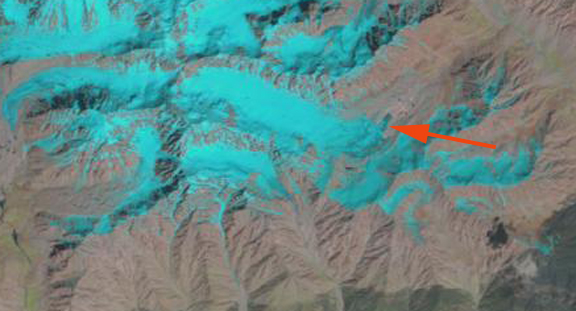December 23, 2009
Zemestan Glacier, Afghanistan Retreats
Posted by Mauri Pelto
The Wakhan Corridor in Afghanistan is not easy to get to, as a result field study of its glaciers are quite limited. This is where the Global land ice Monitoring System (GLIMS) comes in. GLIMS acquires satellite imagery of glaciated areas, making these images available to researchers and processing them to an extent for inventory purposes. GLIMS is led by Jeff Kargel at the University of Arizona. In the Wakhan Corridor a group of glaciers was examined by Umesh Haritashya and others (2009). This recent GLIMS project examined ASTER and Landsat MSS data 1976–2003, in the Wakhan Corridor of Afghanistan. Of the 30 alpine glaciers of varying type, size and orientation examined 28 glacier-terminus positions have retreated, two have been stationary.  The largest average retreat rate was 36 m per year, and the average retreat was 11 m per year. The retreat is evident in a comparison of 1998 Landsat and 2010 Landsat images, note the orange arrow in both. The width and length of the terminus tongue has changed. One of the glacier examined was the Zemestan Glacier. This glacier is 5.3 kilometers long, has an area of 5.2 square kilometers, begins at 5640 meters and terminates at 4800 meters. It is one of many glacier in the Central area of the Wakhan Corridor. Zemestan Glacier has retreated at a rate of 17 meters per year over the study period, a total retreat of 460 meters, 9% of its total length. A comparison of 1998 and 2010 Landsat imagery indicates the retreat of the terminus tongue in width and length at the orange arrows.
The largest average retreat rate was 36 m per year, and the average retreat was 11 m per year. The retreat is evident in a comparison of 1998 Landsat and 2010 Landsat images, note the orange arrow in both. The width and length of the terminus tongue has changed. One of the glacier examined was the Zemestan Glacier. This glacier is 5.3 kilometers long, has an area of 5.2 square kilometers, begins at 5640 meters and terminates at 4800 meters. It is one of many glacier in the Central area of the Wakhan Corridor. Zemestan Glacier has retreated at a rate of 17 meters per year over the study period, a total retreat of 460 meters, 9% of its total length. A comparison of 1998 and 2010 Landsat imagery indicates the retreat of the terminus tongue in width and length at the orange arrows. 
 The glacier has remained snowcovered at its higher elevations at the end of the summer in recent satellite images.
The glacier has remained snowcovered at its higher elevations at the end of the summer in recent satellite images.  This indicates that with current climate the glacier does have a significant accumulation zone and can survive current climate. Continued warming will increase the retreat rate and could threaten its survival. The glacier feeds the Pamir River which in turn drains into the Panj River, to the Amu Darya River and then the Aral Sea. The terminus is on a shallow slope lacks a steep slope and is not extensively crevassed. All of these factors indicate retreat will continue. The glacier has little debris cover unlike many glaciers in the Karakoram-Himalaya-Pamir Ranges such as the Khumbu Glacier or the Zemu Glacier
This indicates that with current climate the glacier does have a significant accumulation zone and can survive current climate. Continued warming will increase the retreat rate and could threaten its survival. The glacier feeds the Pamir River which in turn drains into the Panj River, to the Amu Darya River and then the Aral Sea. The terminus is on a shallow slope lacks a steep slope and is not extensively crevassed. All of these factors indicate retreat will continue. The glacier has little debris cover unlike many glaciers in the Karakoram-Himalaya-Pamir Ranges such as the Khumbu Glacier or the Zemu Glacier 


 Dean of Academic Affairs at Nichols College and Professor of Environmental Science at Nichols College in Massachusetts since 1989. Glaciologist directing the North Cascade Glacier Climate Project since 1984. This project monitors the mass balance and behavior of more glaciers than any other in North America.
Dean of Academic Affairs at Nichols College and Professor of Environmental Science at Nichols College in Massachusetts since 1989. Glaciologist directing the North Cascade Glacier Climate Project since 1984. This project monitors the mass balance and behavior of more glaciers than any other in North America.